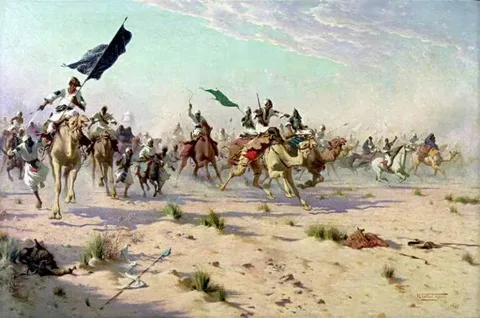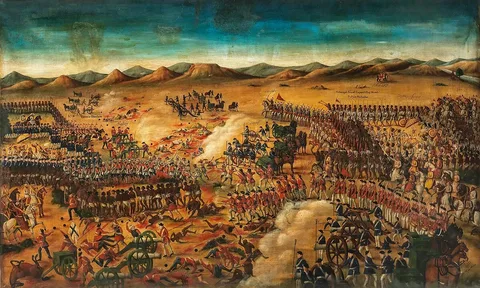The Battle of Banu Qaynuqa’ (2 Hijri/624 CE) marks a significant early confrontation between the Muslims led by Prophet Muhammad (peace be upon him) and the Jewish tribe of Banu Qaynuqa who lived in Medina. This conflict arose shortly after the historic Battle of Badr, signaling growing tensions in Medina as the Muslim community consolidated its political and religious authority.
The battle of Bani Qaenaqaa’

The Banu Qaynuqa were one of the three prominent Jewish tribes residing in Medina and controlled a vital economic stronghold through their market, which was famously known across Arabia. Their economic power and influence initially allowed them to maintain a position within the city under the Constitution of Medina — a treaty that established peaceful coexistence and mutual defense among the diverse tribes and communities of Medina, including Muslims, Jews, and others.
However, following the Muslims’ decisive victory at the Battle of Badr against the Quraysh of Mecca, the Banu Qaynuqa perceived a threat to their own economic and political status. Hostilities grew as the tribe began to oppose the rising influence of the Prophet and his followers. They violated the treaty by engaging in acts hostile to the Muslim community, including reportedly harassing a Muslim woman in the marketplace.
This breach of the peace treaty and the tribe’s defiance forced the Prophet to respond decisively to maintain order and the honor of the Muslim polity.
Read more: The battle of Waddan (1 Hijri)
The Prelude to Battle
After receiving reports of the Banu Qaynuqa’s misconduct, Prophet Muhammad summoned the tribe to their market and admonished them, warning of dire consequences if they persisted in their rebellion and hostility. Instead of reconciliation, the tribe escalated matters, boldly challenging the Prophet and threatening to test the strength of the Muslims in combat. This was considered a de facto declaration of war by some Muslim historians and scholars.
The Quran later reflects upon this incident, with verses revealed concerning the consequences of breaking covenants and the necessity of standing firm against treachery, which implied withdrawal of all concessions and permissible action against the offenders.
The Siege and Conquest
On the 15th of Shawwal in the second year after Hijrah (around April 624 CE), the Prophet mobilized his forces and laid siege to the Banu Qaynuqa’s fortified quarter in Medina. The siege lasted for roughly fifteen days, during which the Muslims maintained pressure on the tribe without direct large-scale battle engagements.
Important companions such as Hamza ibn Abd al-Muttalib carried the banner during the military action, and Abu Lubabah ibn Abd al-Mundhir al-Amri was assigned to oversee Medina itself during the Prophet’s absence.
Despite their strong numbers—a fighting force estimated at around 700 men, many well-armed—the Banu Qaynuqa were unable to sustain their defense, partly due to the weakened alliances with other tribes and possibly some negotiation behind the scenes. Ultimately, they surrendered unconditionally to the Muslims.
Read about: The battle of Badr Al-Kubrah (2 Hijri)
Aftermath and Consequences
Following their surrender, the Banu Qaynuqa faced expulsion from Medina. The Prophet granted an amnesty sparing their lives and families, differentiating this punishment from harsher penalties prescribed under Mosaic law, which might have included execution. Their properties were confiscated as spoils of war, signifying a tangible shift in economic power in the city towards the Muslim community.
The expulsion was systematically carried out under the supervision of ‘Ubaadah bin As-Saamit, a companion who had severed ties with the Jewish tribe and pledged his allegiance to the Muslims.
With the removal of the Banu Qaynuqa, the remaining Jewish tribes in Medina became more cautious, and a period of political and military calm prevailed. Significantly, this event marked the first implementation of khums (the one-fifth share of war spoils allocated for the Muslim community) and solidified the Muslims’ dominance in Medina.
The exile forced the Banu Qaynuqa to relocate primarily to the Levant region (Greater Syria), altering the demographic and political landscape of Medina permanently. It also sent a clear message about the consequences of treaty violations and ensured that the Muslims’ authority was respected by other communities.
Recommend: The battle of Waddan (1 Hijri)
Significance of the Battle
-
Assertion of Muslim Authority: The conflict tested and reinforced Prophet Muhammad’s leadership at a critical stage when nascent Muslim power in Medina was challenged by established tribes.
-
Treaty Enforcement: The battle underscored the importance of upholding the Constitution of Medina. Breach of treaties by any group would no longer be tolerated, establishing a precedent for governance and law enforcement in the growing Islamic state.
-
Religious and Political Unity: The defeat and expulsion of the Banu Qaynuqa increased religious-political cohesion among the Muslims and supportive tribes of Medina, setting the stage for further conflicts and expansion.
-
Economic Control: Removal of the Banu Qaynuqa eliminated significant economic rivals in Medina, enabling Muslim merchants and leaders to gain control over the city’s markets.
-
Moral Example: Prophet Muhammad’s decision to spare lives despite the tribe’s betrayal and threats reflects the measured and merciful approach that would characterize many of his military decisions.
FAQs
When did the Battle of Banu Qaynuqa take place?
It took place in the second year after the Hijrah (2 AH), specifically from the 15th of Shawwal to approximately the 1st of Dhu al-Qa'dah, which corresponds to April 624 CE.
Who were the Banu Qaynuqa?
They were a Jewish tribe living in Medina, controlling a prominent and economically influential marketplace.
Why did the conflict between Muslims and Banu Qaynuqa arise?
The conflict arose because the Banu Qaynuqa violated the Constitution of Medina by hostile actions against Muslims, including breaking oaths, harassing Muslim individuals, and openly challenging the Prophet’s authority.
What happened to the Banu Qaynuqa after their defeat?
They surrendered after a 15-day siege and were expelled from Medina. Their properties were confiscated, and many relocated to the Levant region.
What was the significance of this battle for the Muslim community?
The battle affirmed the Muslims' political control over Medina, enforced the treaty stipulations, united the city’s factions under Islam, and allowed for the implementation of Islamic laws such as khums (war booty division)
Conclusion
The Battle (or siege) of Banu Qaynuqa is a pivotal event that occurred shortly after the Battle of Badr and served to establish the authority of the Muslim community in Medina. It reveals the challenges of maintaining a multi-tribal city-state, where political, economic, and religious interests intertwined and sometimes clashed. The Prophet’s strategic, yet merciful handling of the conflict not only neutralized a threat but also reinforced justice and unity under Islamic governance. This event exemplifies the early Muslim community’s transition from a persecuted minority to a dominant political entity in the Arabian Peninsula, setting important precedents for subsequent encounters with hostile groups.

